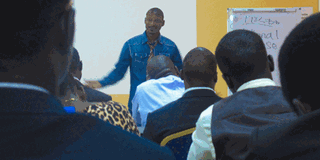Aids is deadly: Is the message really getting through?

Alex Kamukama talks to student leaders at a conference discussing the youth response to the HIV/Aids epidemic in Uganda.
What you need to know:
These factors include individuals who engage in risk behaviours like having unprotected sex, abusing substances like drugs and alcohol, having multiple sexual partners and not knowing your status.
“Let’s leave politics at the side and let’s talk about people,” said Alex Kamukama of the Young People’s Self Coordinating Entity (YPSCE).
This was at a meeting at the Eureka Hotel in Mukono District, earlier last month, with student leaders. Kamukama was emphasising the need to talk about real issues affecting people as far as HIV/Aids is concerned, and less politicking, because as the current numbers show, the prevalence rate has increased by a few percentage points.
Kamukama was right. Involving the public and creating a community dialogue in the response to the HIV/Aids pandemic in Uganda is extremely important because of the various prevention messages of the present and the past.
Since the debut of the first prevention messages in response to HIV/Aids, variations of the Abstain, Be faithful, Condomise (A, B, C) slogan has been a favourite message in Uganda. Though today, with the growing prevalence rate, the need for several messages is desperate and an overall understanding of the infection is much needed.
Because of various misconceptions and ample room for misinterpretation, many Ugandans are confusing messages they receive in their communities, from their peers and in schools. Having a general understanding of HIV/Aids is therefore imperative.
“We as young people have our different needs,” said Kamukama.
He has a personal reason as to why he got involved with YPSCE. When he was 14 years old, his father passed away because of Aids. Soon after Kamukama decided he should get involved in peer education.
“I wanted to understand this disease that took my father away from me who I loved so much,” he said.
As a member of the YPSCE, he helps assemble young people to share ideas, plan interventions and coordinate activities so that the national youth response is synchronised.
How youth are affected
The youth account for a large number of the population and those who are infected by HIV/Aids. According to the 2011 Uganda Aids Indicator Survey, 7.3 per cent of men and women aged 15-24 were HIV-positive. In order to reach all groups at risk of contracting HIV/Aids, the messages need to be altered for each group that is being targeted.
“You need to know the predisposing factors of HIV transmission in that population,” said Nassir Musoke, the prevention manager, Aids Information Centre.
These factors include individuals who engage in risk behaviours like having unprotected sex, abusing substances like drugs and alcohol, having multiple sexual partners and not knowing your status. Youth, individuals with low income, and those with little to no access to educational and medical resources are also likely to transmit HIV.
Peer education initiatives are a more informal approach to informing others about HIV/Aids and other communicable diseases. This type of education allows people of similar backgrounds to interact with individuals like them.
Regan Kiweewa, a peer educator with the Alliance of Mayors and Municipal Leaders Initiative for Community Action on Aids at the Local Level (AMICAALL) communicates to youth who are not in school between the ages of 14-24.
After getting involved with AMICAALL, he discovered the dire need for youth participation in the response to the HIV/Aids epidemic.
“Depending on the messages, we can drop the prevalence rate,” he said.
Generating messages for populations most at risk (such as youth, boda boda riders, and long distance truck drivers) is not difficult, however, organisations are now recruiting individuals of risk groups to teach the public about living with HIV/Aids and how to maintain a negative lifestyle.
Combination prevention approach methods - which involves the use of several messages like use of a condom, abstain or delay sexual activity, testing, and behaviour changes, also ensure a more protected individual .
“You cannot use one intervention for all, they do not fit all,” said Musoke. “You need to know the social dynamics of how people operate.”
Knowing the population will help alter the messages to better suit each population.
Common misconceptions/myths
Myth: You will not get HIV if you have been circumcised.
Fact: Being circumcised only lowers transmission by 60 per cent - it isn’t by 100 per cent).
Myth: You cannot get HIV when having sex on the beach or standing up.
Fact: HIV can be transmitted in any sexual position, be sure to wear a condom to avoid this.
Myth: Mosquitoes can transmit HIV.
Fact: HIV cannot live outside the human body except in syringes.
Myth: Using two condoms will prevent you from getting HIV or pregnant.
Fact: Using two condoms will usually cause friction between the ones the user is wearing, which will rub holes in them.
Myth: From men, it can only be transmitted by ejaculation.
Fact: Men also have pre-ejaculate that can transmit HIV.
Myth: Washing private parts after sex will help prevent you from getting HIV.
Fact: No matter how clean or dirty your body may appear to be, you can still transmit HIV.
Myth: Not knowing your status is better than finding out you are positive.
Fact: Not knowing your status is dangerous to you and your partner(s) health. Not knowing if it is there or not does not make it go away.
Myth: ARVs are a cure.
Fact: ARVs are a treatment. People still get very sick while taking them.
Compiled by Alexander Lopez




